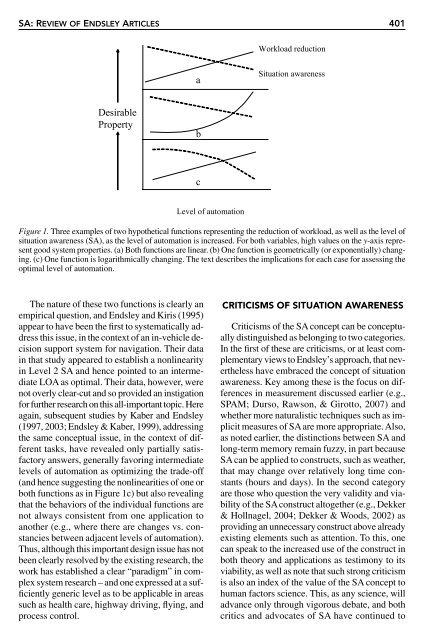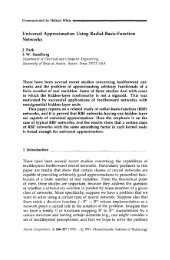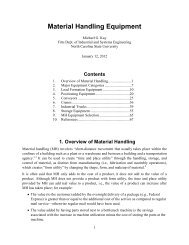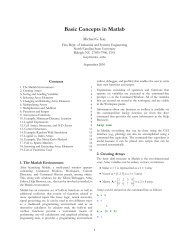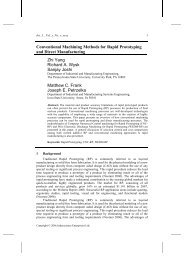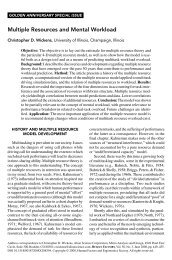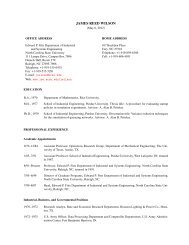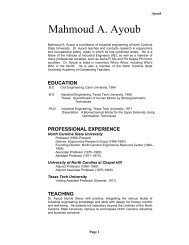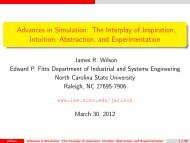Situation Awareness: Review of Mica Endsley's 1995 Articles on ...
Situation Awareness: Review of Mica Endsley's 1995 Articles on ...
Situation Awareness: Review of Mica Endsley's 1995 Articles on ...
You also want an ePaper? Increase the reach of your titles
YUMPU automatically turns print PDFs into web optimized ePapers that Google loves.
SA: REVIEW OF ENDSLEY ARTICLES 401<br />
Workload reducti<strong>on</strong><br />
a<br />
<str<strong>on</strong>g>Situati<strong>on</strong></str<strong>on</strong>g> awareness<br />
Desirable<br />
Property<br />
b<br />
c<br />
Level <str<strong>on</strong>g>of</str<strong>on</strong>g> automati<strong>on</strong><br />
Figure 1. Three examples <str<strong>on</strong>g>of</str<strong>on</strong>g> two hypothetical functi<strong>on</strong>s representing the reducti<strong>on</strong> <str<strong>on</strong>g>of</str<strong>on</strong>g> workload, as well as the level <str<strong>on</strong>g>of</str<strong>on</strong>g><br />
situati<strong>on</strong> awareness (SA), as the level <str<strong>on</strong>g>of</str<strong>on</strong>g> automati<strong>on</strong> is increased. For both variables, high values <strong>on</strong> the y-axis represent<br />
good system properties. (a) Both functi<strong>on</strong>s are linear. (b) One functi<strong>on</strong> is geometrically (or exp<strong>on</strong>entially) changing.<br />
(c) One functi<strong>on</strong> is logarithmically changing. The text describes the implicati<strong>on</strong>s for each case for assessing the<br />
optimal level <str<strong>on</strong>g>of</str<strong>on</strong>g> automati<strong>on</strong>.<br />
The nature <str<strong>on</strong>g>of</str<strong>on</strong>g> these two functi<strong>on</strong>s is clearly an<br />
empirical questi<strong>on</strong>, and Endsley and Kiris (<str<strong>on</strong>g>1995</str<strong>on</strong>g>)<br />
appear to have been the first to systematically address<br />
this issue, in the c<strong>on</strong>text <str<strong>on</strong>g>of</str<strong>on</strong>g> an in-vehicle decisi<strong>on</strong><br />
support system for navigati<strong>on</strong>. Their data<br />
in that study appeared to establish a n<strong>on</strong>linearity<br />
in Level 2 SA and hence pointed to an intermediate<br />
LOA as optimal. Their data, however, were<br />
not overly clear-cut and so provided an instigati<strong>on</strong><br />
for further research <strong>on</strong> this all-important topic. Here<br />
again, subsequent studies by Kaber and Endsley<br />
(1997, 2003; Endsley & Kaber, 1999), addressing<br />
the same c<strong>on</strong>ceptual issue, in the c<strong>on</strong>text <str<strong>on</strong>g>of</str<strong>on</strong>g> different<br />
tasks, have revealed <strong>on</strong>ly partially satisfactory<br />
answers, generally favoring intermediate<br />
levels <str<strong>on</strong>g>of</str<strong>on</strong>g> automati<strong>on</strong> as optimizing the trade-<str<strong>on</strong>g>of</str<strong>on</strong>g>f<br />
(and hence suggesting the n<strong>on</strong>linearities <str<strong>on</strong>g>of</str<strong>on</strong>g> <strong>on</strong>e or<br />
both functi<strong>on</strong>s as in Figure 1c) but also revealing<br />
that the behaviors <str<strong>on</strong>g>of</str<strong>on</strong>g> the individual functi<strong>on</strong>s are<br />
not always c<strong>on</strong>sistent from <strong>on</strong>e applicati<strong>on</strong> to<br />
another (e.g., where there are changes vs. c<strong>on</strong>stancies<br />
between adjacent levels <str<strong>on</strong>g>of</str<strong>on</strong>g> automati<strong>on</strong>).<br />
Thus, although this important design issue has not<br />
been clearly resolved by the existing research, the<br />
work has established a clear “paradigm” in complex<br />
system research – and <strong>on</strong>e expressed at a sufficiently<br />
generic level as to be applicable in areas<br />
such as health care, highway driving, flying, and<br />
process c<strong>on</strong>trol.<br />
CRITICISMS OF SITUATION AWARENESS<br />
Criticisms <str<strong>on</strong>g>of</str<strong>on</strong>g> the SA c<strong>on</strong>cept can be c<strong>on</strong>ceptually<br />
distinguished as bel<strong>on</strong>ging to two categories.<br />
In the first <str<strong>on</strong>g>of</str<strong>on</strong>g> these are criticisms, or at least complementary<br />
views to Endsley’s approach, that nevertheless<br />
have embraced the c<strong>on</strong>cept <str<strong>on</strong>g>of</str<strong>on</strong>g> situati<strong>on</strong><br />
awareness. Key am<strong>on</strong>g these is the focus <strong>on</strong> differences<br />
in measurement discussed earlier (e.g.,<br />
SPAM; Durso, Raws<strong>on</strong>, & Girotto, 2007) and<br />
whether more naturalistic techniques such as implicit<br />
measures <str<strong>on</strong>g>of</str<strong>on</strong>g> SAare more appropriate. Also,<br />
as noted earlier, the distincti<strong>on</strong>s between SA and<br />
l<strong>on</strong>g-term memory remain fuzzy, in part because<br />
SA can be applied to c<strong>on</strong>structs, such as weather,<br />
that may change over relatively l<strong>on</strong>g time c<strong>on</strong>stants<br />
(hours and days). In the sec<strong>on</strong>d category<br />
are those who questi<strong>on</strong> the very validity and viability<br />
<str<strong>on</strong>g>of</str<strong>on</strong>g> the SAc<strong>on</strong>struct altogether (e.g., Dekker<br />
& Hollnagel, 2004; Dekker & Woods, 2002) as<br />
providing an unnecessary c<strong>on</strong>struct above already<br />
existing elements such as attenti<strong>on</strong>. To this, <strong>on</strong>e<br />
can speak to the increased use <str<strong>on</strong>g>of</str<strong>on</strong>g> the c<strong>on</strong>struct in<br />
both theory and applicati<strong>on</strong>s as testim<strong>on</strong>y to its<br />
viability, as well as note that such str<strong>on</strong>g criticism<br />
is also an index <str<strong>on</strong>g>of</str<strong>on</strong>g> the value <str<strong>on</strong>g>of</str<strong>on</strong>g> the SA c<strong>on</strong>cept to<br />
human factors science. This, as any science, will<br />
advance <strong>on</strong>ly through vigorous debate, and both<br />
critics and advocates <str<strong>on</strong>g>of</str<strong>on</strong>g> SA have c<strong>on</strong>tinued to


